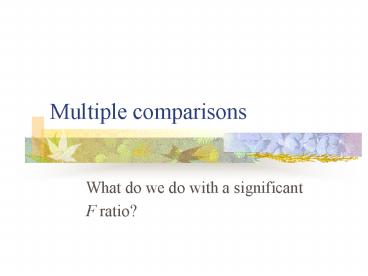Multiple comparisons - PowerPoint PPT Presentation
1 / 13
Title:
Multiple comparisons
Description:
A priori comparisons are planned before the data are collected. ... For example, with three comparisons, set a at .0167, so that the total Type I ... – PowerPoint PPT presentation
Number of Views:147
Avg rating:3.0/5.0
Title: Multiple comparisons
1
Multiple comparisons
- What do we do with a significant
- F ratio?
2
A priori (planned) comparisons
- A priori comparisons are planned before the data
are collected. - One strategy is to allow the Type I error rate
for the study to rise, in order to maximize power
and minimize Type II error rates. - For that strategy to be effective, make very few
two-group comparisons -- the ones specified in
your research hypotheses.
3
Planned comparisons
- Another strategy for planned comparisons sets the
a level lower than .05, in order to keep the
experimentwise error rate at a. - For example, with three comparisons, set a at
.0167, so that the total Type I error rate will
be .0167 .0167 .0167 .05 - That approach sacrifices power, and increases
Type II error. Sound familiar?
4
Orthogonality in planned comparisons
- Some scholars insist that planned comparisons
must be orthogonal or independent. Only k - 1
comparisons can be orthogonal. - Orthogonal comparisons have coefficients which
when multiplied together sum to 0 - Contrast A 1 -1 0 S 0
- Contrast B .5 .5 -1 S 0
- Product (A x B) .5 -.5 0 S 0
5
Using t for planned comparisons
- Using either orthogonal contrast coefficients or
a minimum number of contrasts (textbook
approach), you could compare two groups using the
independent samples t or ANOVA. - t M1 - M2 M1 - M2
- SM1 -M2 SS1 SS2 1 1
- n1 n2 - 2 n1 n2
- But, since you already know MSW, use it
6
t with MSW
- t M1 - M2 M1 - M2
- MSW 1 1 sW2 1 1
- n1 n2 n1 n2
- Obviously, if n1 n2, the denominator
- simplifies to 2sW2/n
7
A posteriori tests
- Several post hoc tests have been developed to
find the differences between means if the ANOVA F
ratio is significant. - Tukeys HSD keeps the total Type I error rate
(the experimentwise error rate) at a. - Newman-Keuls keeps the Type I error rate at a for
each comparison.
8
Tukeys HSD
- Both Tukey and Newman-Keuls use the studentized
range distribution, q, rather than t or F. - qobt Mi - Mj
- MSW/n
- where i refers to the larger mean and n is the
sample size, with all samples being the same
size..
9
Evaluating Tukey
- Use table B-5 to find the critical value of q.
- If qobt gt qcrit, reject H0. If not, retain H0.
- Analogous to the confidence interval approach,
you can simplify multiple Tukey HSD tests by
determining the size of the mean difference (Mi
Mj ) that is significant - HSD q MSW/n
- Any mean differences that equal or exceed HSD are
significant.
10
Newman-Keuls test
- Calculation of qobt is the same as for Tukeys
HSD. - The value of qcrit differs for each comparison,
depending on r, the number of means encompassed
by the two means being compared. - Compare qobt to the appropriate qcrit starting
from the largest and moving down as far as
necessary Logic.
11
The case of unequal sample sizes
- If sample sizes are not equal, but are not
greatly different, either, you may use Tukeys
HSD or Newman-Keuls. - However, what value of n should you use in the
equation? - Use the harmonic mean
- n k .
- (1/n1) (1/n2) (1/nk)
12
The Scheffe test
- This is a very conservative test, with relatively
low power. - F is still equal to MSB / MSW , but MSB is
re-computed using only the two groups being
compared.
MSB
F is compared to the same critical value as for
the ANOVA.
13
Type I Error and Power
- Which of the three approaches has the highest
risk of Type I error? - Which has the most power?































